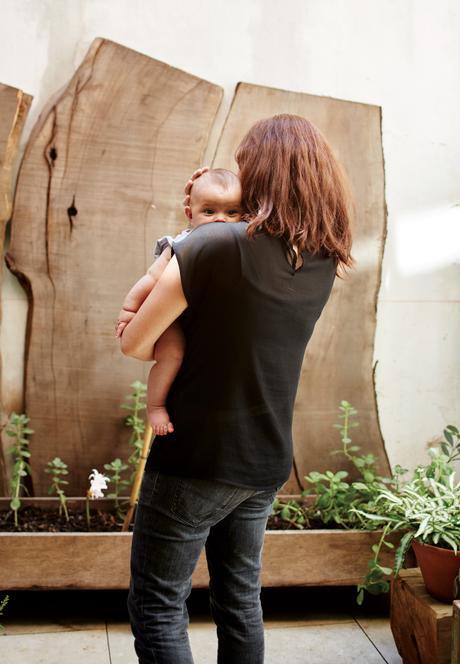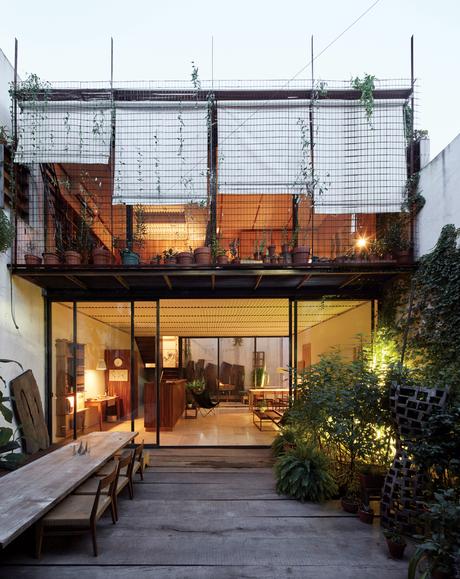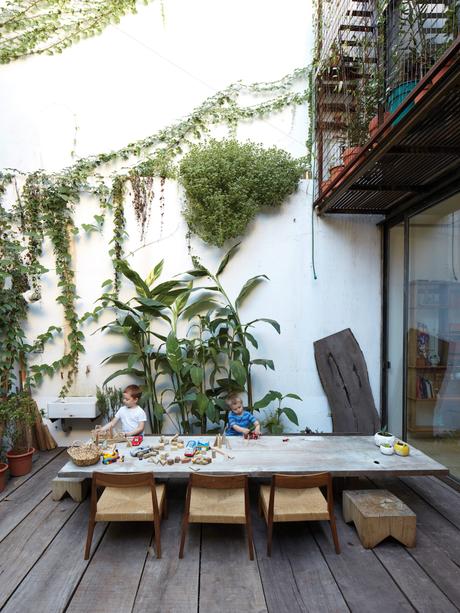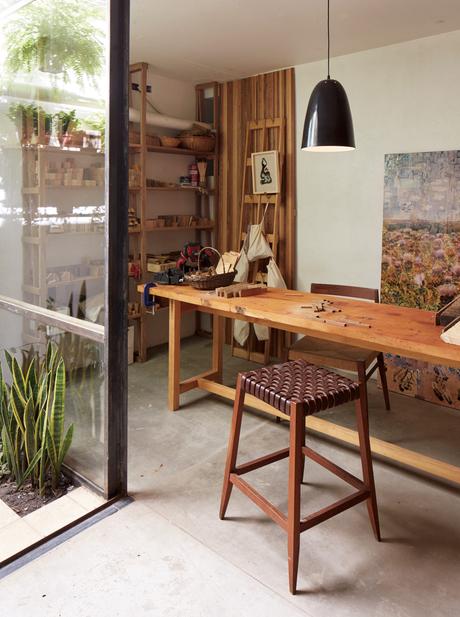
The house architects Teresa Sarmiento and Nicolas Tovo designed for their family—including 1-year-old Clara, for whom the structure is named—is a celebration of recycled materials.
Project Casa Clara Architect Nicolas Tovo and Teresa SarmientoBuenos Aires is an idiosyncratic capital city, with oases of rural tranquility amid an otherwise bustling metropolis. Exploring the city by foot is a guaranteed way to stumble upon sleepy, green-canopied streets, which appear for a few blocks before ending abruptly, and where gentle breeze and birdsong are the only audible interruptions. One such cobbled passageway, on a block smaller in size than the standard 300-foot-by-300-foot city lots, reveals plots of land that are compact and uniform in size. It is unclear what lies behind many of the perimeter walls here, as is the case with Casa Clara; its crumbling whitewashed brick and climbing vines give very little away.
For three years, the house has been a collaborative effort between married architects Teresa Sarmiento and Nicolas Tovo. Over time their plan has been shaped as much by a practical need to build a functional house for an expanding brood (the house is named after the youngest of their three children) as by their desire to create a visually pleasing space. And with its abundance of South American wood and recycled materials, the structure reflects the couple’s journey as architects in every beam.

The patio at the front of the house offers a view of the balcony that connects the second-floor bedrooms.
For the past 15 years, Nicolas has worked alongside Alejandro Sticotti, an esteemed Argentine architect who also runs a design and furniture enterprise called NET. The company’s store, NET Muebles, in the barrio of Palermo, includes a spacious workshop, a source of supplies that was a key factor in determining how Casa Clara took shape. Many of the house’s custom furniture and wooden fixtures were created by NET specifically for the property, with the workshop’s carpenters and blacksmiths facilitating the task. “Our objective was to be austere and frugal with the design,” Teresa says, “with both the materials used and in the construction process.”
Working closely with Sticotti has given Nicolas an appreciation for wood and the value of imperfection. (Raw finishes plus reclaimed and local materials like wood, concrete, and leather were the elder architect’s signatures long before the economic crisis of 2001 made them fashionable.) “Vibration, warmth, and texture are all extra benefits that one gets from wood over other materials,” Nicolas explains. “If you consider the fact that the wood you’re working with is recycled, and therefore has its own story, these values are enhanced exponentially. You can see it in the little details, in the different tones, in the effect that the rusted metal nails have on the surface.”
Teresa, who cites an appreciation of wood as part of her cultural background, specializes in landscape design, which is reflected in the plants she’s cultivated, many of them indigenous Argentine species selected either for their hardiness or to respect the local biosphere. The ivies outside herald the change of seasons, with autumnal hues of brilliant yellows and reds carpeting the patio in vivid colors as they fall. This outdoor space teems with wildlife, attracting hummingbirds and butterflies with its native salvia varieties. Nearby, a low, customized table provides a landing spot for the family’s children.

A custom table surrounded by NET’s Museo chairs and poplar stools provides a space for the Sarmiento Tovo boys, Manuel, 5, and Julián, 3, to play with the toys their mother makes.
“We originally designed the house for ourselves and our first child, Manuel. With the birth of Julián, and then Clara, we decided to react to the potential limitations of space this might present in the long run,” Nicolas explains. “We didn’t want this to force a move, especially as the house was still in progress.” Currently, the couple is planning to build a third floor to create a private space of their own.
The house is situated on a lot of just over 1,100 square feet, and its sliding glass doors create the illusion of an expansive and seamless space for conviviality. The combined kitchen and living room is furnished with a bespoke bar and also includes a bookcase, a modular coat rack, two Tray tables, and a leather Valiant sofa—all made by NET. The dining table is a one-off design with an antique marble top, while the chairs are NET prototypes, not yet on sale.
Both floors of the house were adapted for the children, with bunk beds and plenty of built-in storage. On the rear patio, a child-friendly slatted iron-rod grill allows both light and fresh air to circulate freely to Teresa’s workshop below.

In her workshop, which features a Mercedes table, an Otto lamp, and a wood-and-leather bar stool, all by NET, she creates a line of uncomplicated wood toys called Sarmiento.
In this basement studio, Teresa devotes time to her fledgling design project, Sarmiento, recycling the by-products from NET’s production. Surplus chair-leg prototypes, asymmetrical wooden blocks, and offcuts are fashioned into children’s toys and decorative objects. Like the rest of the house, the workshop is filled with furniture from NET, along with artwork by friends, family, and other Argentine artists. A piece by PAR Paisaje—a creative partnership between Teresa and the artist Violeta Ossani—is embroidered in cotton thread on canvas and framed in marupa wood. It hangs on a modular coat rack by NET.
“We live in a rich, creative environment,” Teresa says. “In some ways it’s a constant learning process. We test-run the prototypes of our own designs, which is why the furniture and objects we have are constantly changing. This evolution and transient nature of things is interesting.”
Indeed, Casa Clara feels like an ever-evolving, self-contained microcosm, where the changes of time are marked not only by the blossoms and turning leaves but also by the growth of the Sarmiento Tovo children, who constantly challenge the malleable boundaries of this beautiful work in progress.
- Log in or register to post comments
